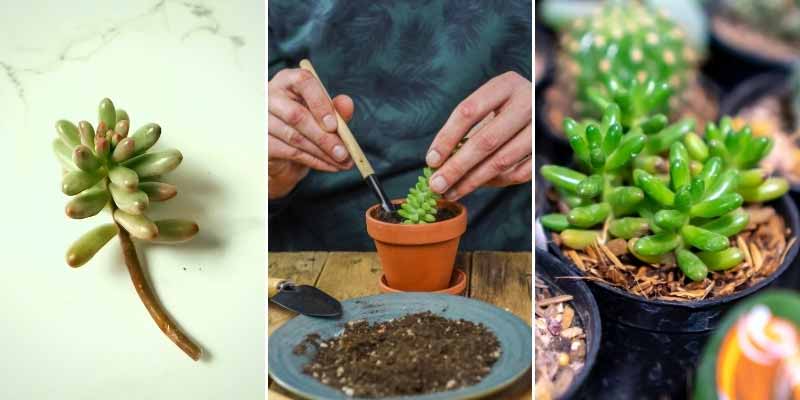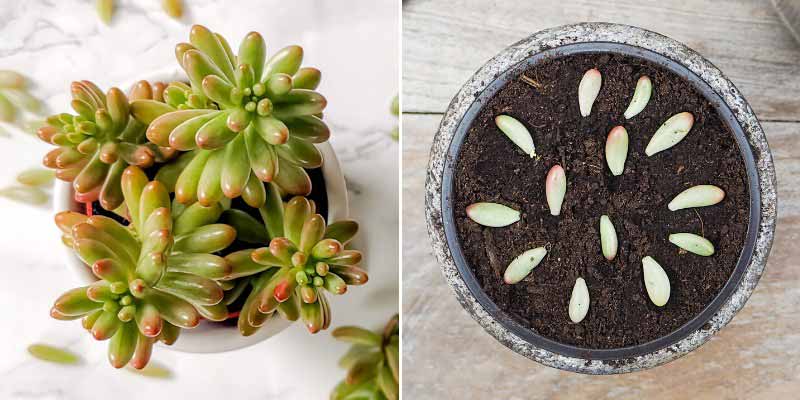Sedum is a beautiful succulent plant that comes in a wide range of varieties with diverse shapes and colours. There are large, upright sedums (Sedum spectabile), which fit easily into borders, and small, mat-forming sedums, which are perfect in pots or in rock gardens. Very drought-tolerant, sedums require little maintenance and are ideal for creating a garden without irrigation. In addition, they are easy to propagate by propagation by cuttings or by division: discover all our tips to succeed !
For more advice on growing them, feel free to consult our full fact sheet: "Sedum or Orpin: how to plant, to grow and to propagate them"
When and how to propagate sedum?
Like most succulents, Sedum is very easy to propagate by cuttings, as it readily and quickly forms new roots when in contact with soil. Ideally, work in late spring, before it starts to flower. Sedum can be multiplied by taking cuttings from its stems or from its leaves.
Propagation by stem cuttings
Stems of mat-forming sedums sometimes root of their own accord when they touch soil: simply separate them from parent plant and replant.
- Start by preparing a pot by filling it with a mix of compost and coarse sand, then firm slightly and water the substrate.
- Take a stem about 10 cm long, cutting just below a node (point where leaves attach to stem). If propagating a small mat-forming sedum with short internodes and small leaves, feel free to take a shorter stem (about 5 cm long).
- Then remove leaves at the base, leaving only a few at top of stem.
- Make a small hole in substrate using a pencil or stick
- Insert base of stem into substrate.
- Firm gently around it to ensure good contact between stem and substrate and avoid air pockets.
- Place pot in a bright spot, out of direct sunlight.
- Continue to water regularly: substrate should remain slightly moist until rooting occurs, which generally takes 2 to 3 weeks.
Materials needed for stem propagation by cuttings
- Pots
- Sharp, disinfected knife
- Light, free-draining substrate, or a mix of compost and sand
- Watering can
- Pencil or stick
- Labels

Propagation by leaf cuttings
- Take a few leaves by detaching them from parent plant.
- Leave them to dry for a few days in open air, out of direct sunlight. This allows wounds to heal and reduces risk of rot.
- Prepare a pot by filling it with a mix of compost and coarse sand.
- Moisten substrate using a spray bottle or watering can.
- Then simply lay the leaves on substrate, without burying them.
- Place pot in a bright spot, but out of direct sunlight.
- Ensure substrate remains slightly moist until rooting occurs.
Materials needed for leaf propagation by cuttings
- Pots
- Light, free-draining substrate, or a mix of compost and sand
- A spray bottle or watering can
- Labels

When and how to divide sedum?
Division is done in early spring (March-April) or in autumn, avoiding periods of frost or very hot weather. Division produces larger young plants more quickly than propagation by cuttings. It is ideal for multiplying Sedum spectabile in particular, but also suits mat-forming varieties.
- Lift young plant of sedum by digging wide enough not to damage roots. If growing it in a pot, remove gently.
- Then divide the parent plant into several clumps using a sharp, disinfected knife. Make sure each clump retains enough roots. If working in autumn, remove dead or damaged leaves and old flowered stems that have dried.
- Replant parent plant in its position, and the new young plants in pots or directly in open ground.
- Water generously.
For creeping sedums, you may see stems around your young plant that have already developed roots where they contact soil. Simply cut them at the base to separate from parent plant, and replant in a pot.
Materials needed for division
- Pots and a mix of compost and sand if you wish to plant it in a pot
- Watering can
- A spade (for large sedums) or a trowel (for mat-forming varieties) to lift sedum plants
- Knife

To go further
- To learn everything about their cultivation, consult our full fact sheet "Sedum or Orpin: how to plant, to grow and to propagate them"
- Discover our whole range of sedums































![[plant multiplication method="division"]Sedums can be easily multiplied by division. [/plant] This method involves separating the plant into smaller sections and replanting them in new locations. [plant id="sedum"]
The Sedum can be propagated by division, cuttings, or seeds. Division is the simplest method: separate the clumps in spring or autumn and replant them. For cuttings, take stem cuttings in spring or summer, let them dry for a few days, then plant them in a well-draining soil mix. Finally, seeds can be sown in spring or autumn in a seed tray filled with a mix of compost and sand. Keep the tray moist and place it in a warm, bright location.](https://en.promessedefleurs.eu/blogwp/wp-content/uploads/2023/03/Comment-multiplier-les-sedums-.jpg)
Comments